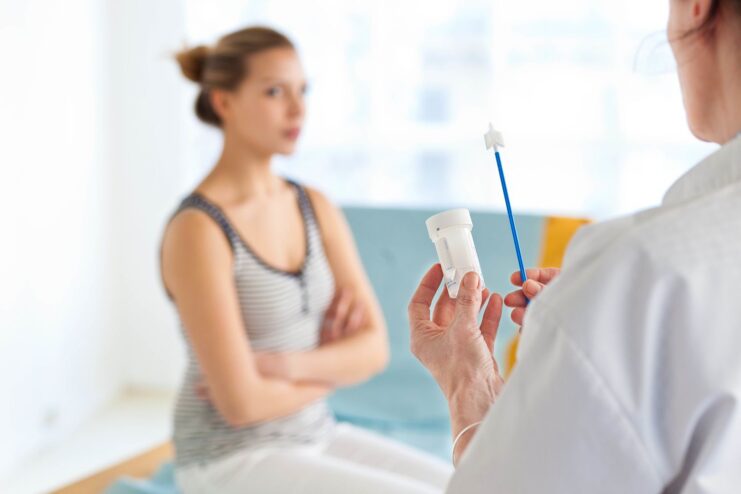Many women are confused when it comes to vaginal discharge. However, often this isn’t a topic you would openly discuss with your friends or even your doctor.
I see you’ve stumbled upon this article, and I can just imagine the whirlwind of emotions you might be feeling. Trust me, I’ve been there, and I totally understand your concerns. “Vaginal discharge – should I be worried?” This question has haunted many of us, whether whispered in the locker room or typed into Google with trembling fingers.
So, take a deep breath, grab a comfy seat, and let’s dive into the world of vaginal discharge together! I’ll be your big sister, your best friend, and your confidante in this journey. We’ll explore the ins and outs of this natural bodily function, and by the end of this article, you’ll know whether or not you should worry.
Spoiler alert: most of the time, it’s absolutely normal! But it’s always better to be well-informed, right?
So, let’s get started, my friend!
Vaginal Environment

Understanding the vaginal environment is key to maintaining optimal vaginal health. A healthy vagina is a self-regulating, dynamic ecosystem that harbors a delicate balance of bacteria, specifically lactobacilli, which play a crucial role in maintaining vaginal health. Let’s take a closer look at some essential aspects of the vaginal environment:
- pH Balance: A healthy vagina has a mildly acidic pH level, typically ranging between 3.8 and 4.5. This acidity helps keep harmful bacteria at bay, while promoting the growth of beneficial lactobacilli. Factors such as menstruation, semen, and certain hygiene products can temporarily alter the pH balance, potentially leading to infections or discomfort.
- Lactobacilli: These “good” bacteria are essential for a healthy vaginal environment. They produce lactic acid and hydrogen peroxide, which help maintain the acidic environment and prevent the overgrowth of harmful bacteria. A decrease in lactobacilli can lead to an imbalance in the vaginal flora, potentially resulting in infections like bacterial vaginosis or yeast infections.
- Vaginal Discharge: As we’ve discussed earlier, vaginal discharge is a normal and necessary part of the vaginal environment. It helps cleanse the vagina and cervix by flushing out dead cells and bacteria. The color, consistency, and amount of discharge can vary depending on factors such as hormonal changes, menstrual cycle, and overall health.
- External Factors: External factors, such as hygiene practices, sexual activity, and personal care products, can also impact the vaginal environment. To maintain a healthy vaginal ecosystem, it’s important to practice good hygiene, choose gentle, unscented products, and engage in safe sex practices.
Normal and ovulation discharge
Clear, whitish, thin or thick odorless discharges are usually normal and shouldn’t be alarming. It can happen at any time during your menstrual cycle. This discharge means your reproductive organs are ‘cleansing’ the vagina and cervix, getting rid of dead cells and bacteria which is being transported by these discharges.
Somewhere around the 14th day of your cycle (i.e when an egg is released from your ovary -termed ovulation), you may notice clear colorless and elastic discharge resembling egg white. It is usually much more in amount than your usual vaginal discharge. This is a good sign for those who are trying to conceive as this is when you are most fertile.
Sometimes, white and more watery discharge can be found after heavy physical activities when you are sexually excited or sometimes when you feel extremely tired.
Common causes are Infections, Hormonal Imbalance, Vaginal Environments Changes and maybe it’s just Normal Discharge!
Menses discharge

Menses discharge, or menstrual flow, is a natural part of the menstrual cycle that occurs in women of reproductive age. During menstruation, the body sheds the uterine lining (endometrium) in the form of blood and tissue through the vagina. Here’s what you need to know about menses discharge:
- Color and Consistency: Menstrual blood can vary in color and consistency, ranging from bright red to dark brown. At the beginning of your period, the blood is usually bright red, indicating fresh blood. As your period progresses, the blood may turn darker, even appearing brownish, which is a result of the blood taking longer to leave the body and oxidizing. The consistency can also vary from thin and watery to thick and clumpy, depending on the presence of tissue and blood clots.
- Duration: The duration of menstrual flow varies among individuals, typically lasting between 3 and 7 days. It’s essential to monitor your period’s length and flow to ensure it falls within a normal range. If you experience unusually short or long periods, excessively heavy or light flow, or sudden changes in your menstrual pattern, consult a healthcare professional.
- Menstrual Cycle: A complete menstrual cycle ranges from 21 to 35 days, with an average of 28 days. The cycle starts on the first day of your period and ends on the day before your next period begins. Regular monitoring of your menstrual cycle can help you understand your body’s patterns and identify any potential irregularities.
- Menstrual Hygiene: Maintaining proper hygiene during menstruation is essential for overall vaginal health. Change sanitary pads, tampons, or menstrual cups regularly to prevent bacterial overgrowth and reduce the risk of infections. Opt for unscented, high-quality menstrual products, and wash the vaginal area gently with mild soap and water.
Infections

Click here for details on STD Screening for Women
Bacterial vaginosis (vaginal infection caused by bacteria) is one of the most common causes of gray, foul fishy-smelling vaginal discharge. Redness of the vulva, itching, and burning sensation during intercourse may accompany. Green, thick fishy-smelling discharges are commonly caused by Gardnerella infections.
Gonorrheal infections are manifested by cloudy yellow discharge often accompanied by pelvic pain and frequent urination. Trichomoniasis (a parasitic infection) gives a yellowish frothy discharge with a bad odor. This is usually transmitted through unprotected sex. These infections are commonly treated with over-the-counter antibiotics, the most effective one being metronidazole in the form of tablets, vaginal gel/creams, and suppositories. White, cottage cheese-like discharge often accompanied by itching is due to yeast infection known as candidiasis. Other types of infections that you could get which could cause abnormal vaginal discharge includes chlamydia, ureaplasma, and mycoplasma. Click here for Info on STD Symptoms in Women
If you are pregnant, consult a doctor before taking any medications. Pay attention to your personal hygiene. Changing your panty liners frequently, and keeping your feminine area cool and dry by avoiding tight clothing and linen panties may help prevent from such infections.
Lifestyle
We must not overlook some other simple facts that may lead to changes in normal conditions of the vagina. Decreased bacterial count and an increased vaginal pH of more than 4.5 are the main culprits causing infection. You may not notice that using fragrant soaps, vaginal douching, and frequent bubbly baths may be some of the causes.
For those who are sexually active, sticking to one partner is the best prevention, as STDs are often associated with such infections. Pregnancy and menopause may sometimes lead to imbalanced vaginal conditions due to hormonal changes. It is the best to maintain a good personal hygiene. Although less frequently red discharge or spotting is a more serious case.
When this is noted, question yourself: Have you had any unprotected intercourse recently? If yes, this may be a sign of pregnancy and you might want to do a pregnancy test. Spotting during early pregnancy may mean miscarriages or threatened abortion. Some other reasons are vaginal tears and lacerations during rough intercourse, and, if you are more than 40, it may be due to cancer.
This is the time when you should be worried and tell your doctor.
Hormonal Influences on Vaginal Discharge

Our bodies are finely tuned machines, with hormones playing a significant role in regulating various functions, including vaginal discharge. Factors like puberty, pregnancy, menstrual cycles, birth control, and menopause can all impact the amount and consistency of discharge.
For example, an increase in estrogen levels can lead to more discharge, while hormonal imbalances may cause changes in color, consistency, or odor. It’s essential to pay attention to any sudden changes in discharge, as it may be indicative of a hormonal issue that requires medical attention.
Managing Vaginal Discharge
To maintain optimal vaginal health and manage your discharge, consider the following tips:
- Use unscented, mild soap for cleaning the vaginal area
- Avoid douching, as it can disrupt the natural balance of bacteria
- Wear breathable, cotton underwear to prevent excess moisture
- Change sanitary pads or tampons regularly during menstruation
- Maintain a healthy lifestyle, including a balanced diet and regular exercise
- Practice safe sex and get regular check-ups to prevent sexually transmitted infections
Myths Debunked
There are numerous misconceptions about vaginal discharge that can lead to unnecessary worry or confusion. Here are a few myths debunked:
- Myth: Vaginal discharge is a sign of poor hygiene. Fact: Discharge is a natural bodily function and an essential part of maintaining a healthy vagina.
- Myth: All vaginal discharge is abnormal and should be treated. Fact: Most discharge is normal, and only in specific cases, such as infections or hormonal imbalances, does it require medical attention.
The Connection Between Diet and Vaginal Discharge

What we eat can impact our overall health, including the health of our vagina. A well-balanced diet, rich in nutrients, can help maintain a healthy vaginal environment. Here are some dietary tips to support vaginal health:
- Stay hydrated by drinking plenty of water, as it can help flush out toxins and maintain healthy vaginal discharge
- Consume probiotic-rich foods like yogurt, kefir, and sauerkraut to support a balanced vaginal microbiome
- Eat a diet rich in fruits, vegetables, whole grains, and lean proteins to provide the nutrients needed for optimal vaginal health
- Limit consumption of processed foods, refined sugars, and excessive caffeine, as they can contribute to inflammation and disrupt the natural balance of bacteria in the vagina
By following these guidelines and staying informed about vaginal discharge, you can take charge of your vaginal health and feel confident in your body.
FAQ
Can changes in vaginal discharge be an early sign of pregnancy?
Yes, changes in vaginal discharge can be an early sign of pregnancy. Pregnant women often experience an increase in discharge, which is typically clear or white, with a thin, milky consistency. This discharge, known as leukorrhea, is a result of hormonal changes and helps protect the developing fetus from infections. However, it’s important to note that changes in discharge can also be due to other factors, so it’s best to take a pregnancy test or consult a healthcare professional for confirmation.
How can stress affect vaginal discharge?
Stress can have an impact on various aspects of our health, including hormonal balance. When we are stressed, our bodies release cortisol, which can disrupt the delicate balance of hormones in our system. This hormonal imbalance can lead to changes in the color, consistency, or amount of vaginal discharge. To minimize the effects of stress on your vaginal health, try incorporating stress-reduction techniques like meditation, yoga, or exercise into your daily routine.
Is it normal for vaginal discharge to have an odor?
A mild odor is normal for vaginal discharge, as it contains a mixture of bacteria, dead cells, and bodily fluids. However, a strong, foul, or fishy odor can be a sign of an infection, such as bacterial vaginosis or a sexually transmitted infection. If you notice a significant change in the odor of your discharge, consult a healthcare professional for evaluation and treatment.
Can using lubricants during sex affect vaginal discharge?
Using lubricants during sex can temporarily affect the consistency and amount of vaginal discharge. Water-based lubricants are generally safe to use and are less likely to cause irritation or disrupt the natural balance of bacteria in the vagina. However, avoid using oil-based lubricants, as they can potentially damage latex condoms and increase the risk of infection.
Conclusion
Vaginal discharge is a natural and essential part of maintaining a healthy vagina. Understanding the factors that can influence your discharge, such as hormonal changes, diet, and lifestyle, can help you take charge of your vaginal health. By staying informed, practicing good hygiene, and seeking medical advice when necessary, you can confidently navigate the world of vaginal discharge and ensure optimal reproductive health. Remember, it’s always better to be well-informed, and there’s no shame in seeking answers to your questions or concerns about this natural bodily function.













